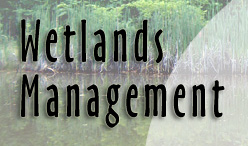|
|
|
|
|
|
Wetland types |
|
Peatlands |
|
Ecology |
page 4 of 7 |
Many unique plants and animals inhabit peatlands due
to the unique physical and chemical properties that occur in these
wetlands. The Sphagnum mosses are the primary peat-building plants
in bogs. The mosses grow only on the surface layer at a rate of
one-quarter to four inches per year. The layers at the bottom of the
sphagnum mat die and slowly convert to peat. A variety of emergent
plants often grow on the surface including cotton grass, sedges,
cranberries, and blueberries. Trees can also grow but are often
stunted and may be less than five feet tall even after hundreds of
years. In peatlands further south, botanical diversity is often
greater than in northern areas.
Bogs, if you recall, have limited surface and groundwater flow. This
results in low amounts of nutrients available to plants. To
compensate for the low nutrient availability many bog plants have
developed unique adaptations to compensate for the lack of
nutrients. The pitcher plant and sundew are two unique species that
have adapted to low nitrogen levels by becoming carnivorous.
Invertebrates, amphibians, and even small mammals may fall into the
modified leaves that hold water. The pitcher plant leaves than
extract the nitrogen from the animal and thus avoids nutrient
deficiency. Other plants associated with bogs include sphagnum moss,
cotton grass, cranberry, blueberry, pine, Labrador tea, and
tamarack.
A relatively large number of mammals and birds, and lesser numbers
of reptiles and amphibians inhabit peatlands. Large mammals such as
moose and caribou routinely inhabit peatlands. A number of small
shrew species also live in peatlands. Birds, including waterfowl,
inhabit peatlands. However, the large numbers seen in other wetland
types are often absent due to a lack of open water. Numerous
songbirds, owls, and rails also inhabit peatlands.
A different set of plants are found in pocosins including
loblolly bay, red bay, and sweet bay, and evergreen shrubs
like titi, fetterbush, and zenobia. Pocosins provide
important habitat for many animals, including some
endangered species like the red-cockaded woodpecker. They
are especially important as the last refuge for black bears
in coastal Virginia and North Carolina, and the red wolf has
recently been reintroduced in North Carolina pocosins.
|

